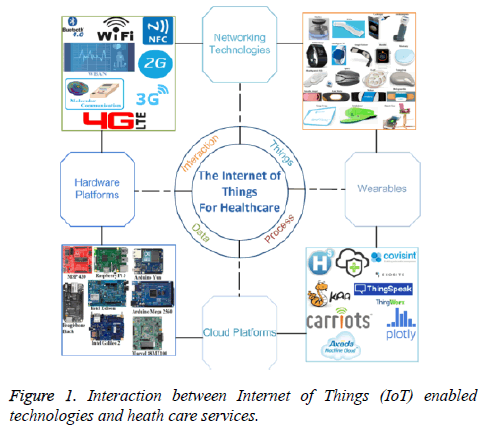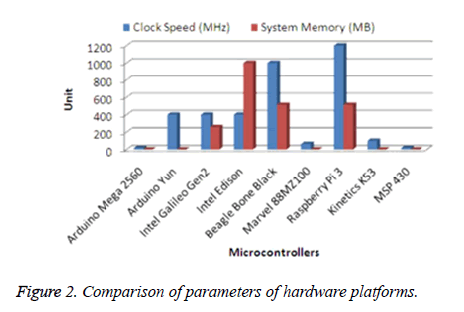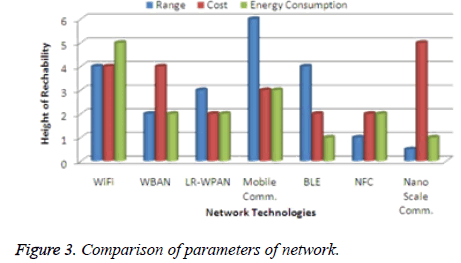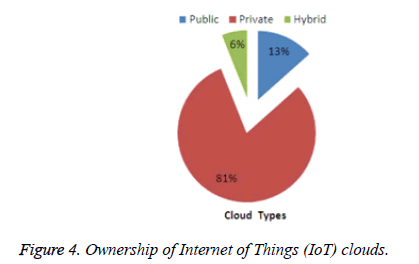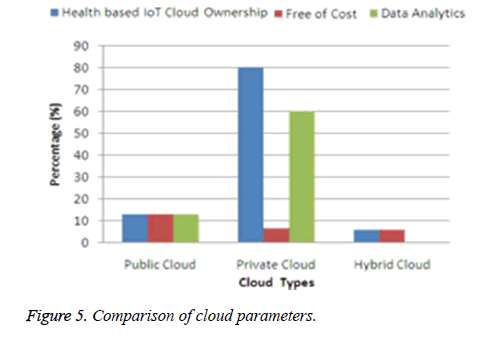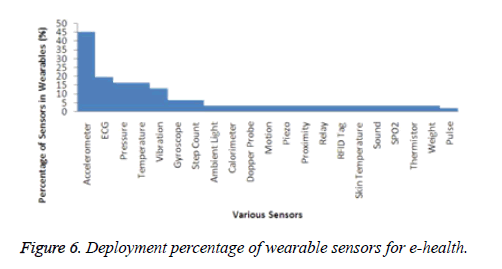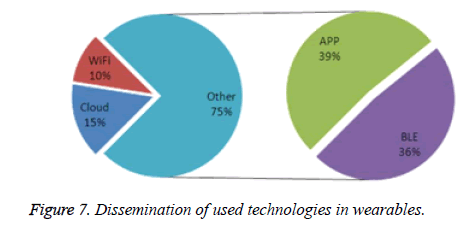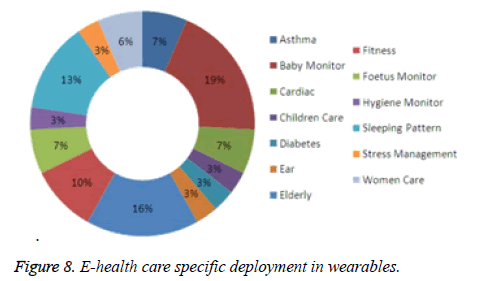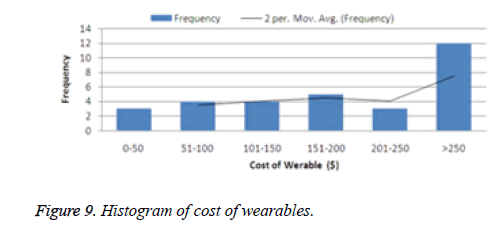ISSN: 0970-938X (Print) | 0976-1683 (Electronic)
Biomedical Research
An International Journal of Medical Sciences
Research Article - Biomedical Research (2017) Volume 28, Issue 4
Understanding the role of internet of things towards smart e-healthcare services
Partha Pratim Ray*
Department of Computer Applications, Sikkim University, 6th Mile, Gangtok, Sikkim, India
- *Corresponding Author:
- Partha Pratim Ray
Department of Computer Applications
Sikkim University, India
Accepted on August 24, 2016
Introduction: Internet of Things and allied components i.e., cloud, hardware platforms, communication technologies, wearable systems and its challenges are described for seamless integration with telemedicine and e-health.
Materials and Method: Comparison between Internet of things based existing cloud platforms, wearables, hardware, and network technologies are performed to provide clear picture of how these are correlating with current smart e-healthcare services. Percentage and taxonomical representation of parameters are measured by taking various surveyed items. Related technological challenges are visited which shall be taken care of researchers.
Results: 9 hardware platforms, 31 popular internets of things enabled wearables, 15 cloud platforms, and 7 network technologies have been investigated according to specified parameters that best meet their suitability for dissemination of e-healthcare services. Out of 9 hardware platforms Raspberry Pi 3 has maximum clock speed of 1.2 GHz whereas maximum amount of system memory sized 512 MB claiming to be most effective platform to be used for design of e-health solutions. Public, private, and hybrid clouds dominate 6%, 13%, and 81%, respectively. 21 different sensors are found to have used in all 31 wearables. Accelerometer and ECG sensors are the two mostly used sensors having 45.1% and 19.3 % implementations respectively. Cloud, Wi-Fi, APP, and Bluetooth Low-Energy (BTLE) supported deployments into wearables are found to be 38.7%, 25.8%, 100% and 93.5% respectively. Baby and elderly monitor solutions do capture 19.3%, and 16.1% of whole wearables. 38.7% of the wearables per unit price costs more than 250 $. Bluetooth Low-Energy (BTLE) and Low-Rate Wireless Personal Area Networks (LR-WPAN) communications are found to be two most promising technologies for ehealthcare services.
Conclusion: This study inculcates the appropriateness of internet of things in many forms for conjugation with smart e-healthcare.
Keywords
Smart wearables, E-healthcare, Pervasive healthcare, Ubiquitous healthcare, Internet of things (IoT).
Introduction
This decade has witnessed the rapid growth of technological uplifts in many fields of research [1,2]. Internet of Things (IoT) is the most recent one that has already started to impart huge impact on every aspects of lives i.e., environment [3], industry [4], sports [5,6], entertainment [7], social computing [8], agriculture [9], food processing [10,11], defence [12], education [13], astrophysics [14], city lives [14,15] etc. Ehealth care service is the crucial area upon which human lives depends the most. Researchers are constantly engaged with the invention intensive approaches towards development of novel applications on e-health care and medical science. Internet of Things (IoT) plays the key part in this section. As shown in Figure 1, Internet of Things (IoT) may be seen as composition of four fundamental sectors such as, Interaction, Things, Process and Data in short (ITPD). In 2014, this Interaction, Things, Process and Data in short (ITPD) ring was explained by Ray [6], where interaction means how user gets attached with the system (e.g., network technologies 2G, 3G, 4G, Wi-Fi (Wireless Fidelity), Near-field communication (NFC), Bluetooth Low Energy-BTLE etc.); Things (e.g., wearable devices) represents various objects that gather Data (e.g., raw sensor data, hardware and cloud processed data) from surroundings by intervention of sensors, while process (e.g., operations performed by cloud and hardware platforms) is the core of these parameters to efficiently manage and correlate with user and Internet of Things (IoT) enabled technologies.
According to a recent report, the adoption of Internet of Things (IoT) may bring exceptional changes in the operational efficiency to hospitals and surgical centers in managing day-today clinical operations, and tracking e-health status of hospitalized patients [16]. The scientists are currently trying to form such solutions around Internet of Things (IoT) that can have better control over the operational process and get effective to reduce the time to provide better care for mankind. Cost efficiency, reliability, and safety are the desired goals achieved with Internet of Things (IoT) applications in the ehealthcare sector [16]. It is worth to be noted that, the global Internet of Things (IoT) e-healthcare market is estimated to grow from $32.4 Billion in 2015 to $163.2 Billion by 2020, at a Compound Annual Growth Rate (CAGR) of 38.1% during this forecast period [16]. In this context, it is obvious to comprehend that study of applicability of Internet of Things (IoT) on e-health care sector is indeed a need of present time. A thorough understanding of current status of Internet of Things (IoT) enabled technologies in relation with various wearables that are currently being used in e-health care, is expected to be most useful for various stakeholders who are interested in further research [17]. Particularly, the aspect of connected wearables and their integrity with Internet of Things (IoT) empowered technologies is definitely the most important matter of study. In summary, this paper contributes as follows
• Study and comparison of IoT supported parameters such as hardware, communication technologies, and cloud platforms to find out suitability for e-health care services;
• Comparison of existing IoT based wearables solutions for e-healthcare;
• Identification of challenges associated with IoT aware ehealth care domain;
• Analysis of results obtained from this rigorous study.
Materials and Methods
The key question of this study seeks the answer why is Internet of Things (IoT) capable to provide seamless and pervasive support to e-health care? To find the answers of this query, a list of five checks have been performed.
Firstly, A thorough review of the 9 different resource constrained (i.e., less amount of memory, processor speed, capacity, bus width, and size) hardware platforms has been carried away to perform comparison on operating voltage, clock speed (MHz), bus width (bits), system memory, flash memory, Electrically Erasable Programmable Read-Only Memory (EEPROM), communication supported, development environments, programming language, and Input/output (I/O) connectivity. Mainly, two types of processor families have been sought for this purpose such as, RISC (Reduced Instruction Set Computer) e.g., Arduino Mega 2560, Arduino Yun, Beagle Bone Black, Kinetics K 53, MSP 430, Marvel 88 MZ 100, Raspberry Pi 3, and Kinetics K 53; CISC (Complex Instruction Set Computer) e.g., Intel Galileo Gen 2, and Intel Edison. While performing this review, online magazines (e.g., www.makezine.com, www.sciencemag.org etc.), sites (e.g., www.postscapes.com), and research papers [1,3,5,6,17,18] have been gone through.
Secondly, various communication technologies have been compared based on their standards, frequency band, data rate transmission range, energy consumption, and cost for application towards e- health applications. In this search, it has been focused to facilitate Internet of Things (IoT) formulated resources be it hardware, wearables, or cloud. Main priority was given to Wi-Fi, LR-WPAN (Low-Rate Wireless Personal Area Networks), Bluetooth Low Energy (BLTE), NFC (Near Field Communication), Mobile Communication (2G, 3G, 4G), WBAN (Wireless Body Area Network), and nano scale communication [19] (study on bio communication between cellular components like cell, neurons etc., of human body).
Thirdly, 15 existing Internet of Things (IoT) cloud platforms have been investigated based on real time access, data visualization, data capture, data analytics, cloud service type, and cost. In this context, a cloud can be viewed as a service that delivers the on demand computing resources from utilities to data centers on a pay-as-you go basis or free. Basically, Internet of Things (IoT) cloud platforms are meant to provide numerous solutions for developers to build and deploy powerful Internet of Things (IoT) applications (e.g., medical, hospital, and emergency services), tools for device manufacturers to quickly incorporate newly connected services to the products and perform actions between machines (devices/things) and social networks, and much more [20].
Fourthly, 31 different wearables e-health solutions have been tracked down in this work to study about usability of sensors, applicability among several genres of population, and detecting parameter (e.g., baby monitor, women e-health, elderly, cardiac, fitness etc.). Finally, after gathering of required amount of information on hardware platform, communication technologies, cloud solutions, and wearables, next job was to analyse the data to seek valuable answers about few questions such as,
• Which hardware platform is suitable for development of Internet of Things (IoT) based e-healthcare products?
• Which network technologies pave crucial role in Internet of Things (IoT) supported e-healthcare communications?
• What are the percentages of ownerships among e-health care based Internet of Things (IoT) cloud platforms where cost and analytics tools are heavily involved?
• What are the dissemination percentages of Wi-Fi, Cloud, APP, and BLE (Bluetooth Low Energy) in Internet of Things (IoT) based wearables?
• What is the usage pattern of wearable sensors?
• What is the deployment percentage of area specific Internet of Things (IoT) based wearables?
Results
As mentioned in previous section, in total 9 different hardware platforms, 7 network technologies, 15 cloud platforms, and 31 Internet of Things (IoT) supported wearables were taken into consideration while finding the results. Figure 2 shows the comparison of 9 Internet of Things (IoT) enabled hardware platform based on their individual clock speed (Mega Hertz) and system memory (Mega Byte). Raspberry Pi 3 seems the most promising platform having 1200 MHz of clock speed (highest of all) and system memory of 512 MB. Whereas, Arduino Mega 2560 possess clock speed of just 16 MHZ and 8 KB of system memory. Other platforms do have range of clock speed in between 100-1000 MHz. Beagle Bone Black is one of the crucial competitors having clock speed of 1000 MHz and 512 MB system memory. Though, Intel Edison has 1000 MB system memory it lacks far behind in clock speed-400 MHz. Figure 3 presents comparison between Internet of Things (IoT) enabled network technologies based on range, cost, and energy consumption. While performing this task, marking between 0-6 have been made to consider following height of reach ability: Very very high-6, very high-5, high-4, medium-3, low-2, very low-1, and very very low-0.5. It is found that Wireless Body Area Network (WBAN) and Bluetooth Low Energy (BLE) are two most capable technologies that have appropriate amount energy consumption from very very low (i.e., Nano scale communication, Bluetooth Low Energy (BLE))-medium (i.e., Wireless Body Area Network (WBAN)). Their cost and range are reasonably good (i.e., medium) for development of Internet of Things (IoT) based e-health care solutions. 15 Internet of Things (IoT) cloud platforms have been investigated to seek how these clouds can help in e-health care domain. Figure 4 shows the current ownership of clouds in terms of public, private, and hybrid. It is found that 81% of overall clouds do belong to private owners and whereas hybrid and public clouds capture 6% and 13%, respectively. This necessitates the probable growth in public sector so that the cost of storing medical data could be minimized. It is also noticed that access cost of privately owned Internet of Things (IoT) clouds is highest of all as shown in Figure 5. Figure 5 also compares between public, private, and hybrid Internet of Things (IoT) clouds where data analytics services are enabled in 60% of private clouds. Data analytics service is used to analyse user medical data remotely in cloud servers. Further, this outcome may help users to predict whether any e-health problem may arise in future allowing the user to modify life style. Hybrid clouds do lack both in ownership and cost than others do. It is also surprising to note that no data analytics service (i.e., 0%) is currently equipped with the hybrid cloud platforms, which makes its applicability in e-health care very much restricted. Public cloud holds all the fields’ equal-13.3%.
affecting current scenario of Internet of Things (IoT) based ehealthcare market. Whereas, Figure 6 shows 21 different sensors that are presently enabled with these wearables. Standard percentage (used/total number) comparisons were performed while measuring the usage patterns of these sensors. It is worth to be noted that accelerometer is the mostly deployed sensor of all i.e., 45.1%. Subsequent positions are captured by the ECG (19.3%), pressure (16.1%), temperature (16.1%), and vibration (12.9%) sensors respectively. Gyroscope and step count sensors are deployed among 6.45% of all the wearables. But it is also found that 41% of the mentioned sensors are currently being used only in 3.2% of all wearables. Figure 7 shows that 25% of wearables deploy Wi-Fi and cloud as its core enabler technologies. Surprisingly, 75% of this deployment is governed by Bluetooth Low Energy (BLE) and APP based solutions.
It is also counted that 100% of the wearables do use Bluetooth Low Energy (BLE) as core technology to transfer medical data to the users which is a good sign of low power and green approach towards better future. Figure 8 presents the deployments of currently examined wearables in 13 various ehealth care services. Baby monitor, elderly care, and sleeping pattern monitoring supported wearables are currently leading the market in terms of variations and viabilities capturing 19.3%, 16.1%, and 12.9%, respectively. If children are considered to belong the set of foetus and teen age, then 28.9% of total wearables are presently being served to monitor their health. Fitness bands are getting continuously popularized among other wearables. The percentage of usage is 9.6%; which looks promising at current scenario. Asthma, cardiac, and women health care supported wearables do hold each of 6.4% of global wearables usage. Figure 9 illustrates the histogram of cost of the wearables. The horizontal axis (Xaxis) represents the cost in dollar ($) and vertical axis (Y-axis) marks the frequency i.e., occurrence of wearables in the same zone. 38% (12 of 31) of the wearables do cost more than 250 US $ per unit. Whereas, only 9% (3 of 31) of wearables lie under the mark of 50 US $ per unit. It is also found that average per unit cost of 41% (13 of 31) of the wearables fall in the range of 51-200 US $.
Discussions
In this literature, we have surveyed various hardware, cloud platforms, communication technologies, and wearables that do act as supporting enablers of Internet of Things (IoT) to understand how Internet of Things (IoT) is affecting the ehealthcare domain in terms of usability, applicability, and sustainability. In a recently published article [21], various hypothetical applications and challenges of Internet of Things (IoT) based healthcare are presented. Similar concept is also sought that seeks the applicability of Internet of Things (IoT) in healthcare from system design perspective [22]. Hiremath et al. have recently shown the relationship between Internet of Things (IoT) and wearables in terms of architecture and person centric approach [23]. An architecture for IoT based smart sports is proposed to leverage the interconnectivity of sports persons with public through intelligent technological means [24]. Though these works do leverage various components and describe several notions of e-healthcare but Internet of Things (IoT) based technological acceptance and their suitability have never been thought of.
Here in this paper, various forms of Internet of Things (IoT) have been examined in accordance with susceptibility of the wearables (sensors, usage, and their cost) to provide overall and detailed exposure about current trends of dissemination on the hardware, cloud, and communication technologies so that general readers, enterprises, and technologists do infer competent knowledge about what the current scenario is and how to go ahead in this field. Few technical and methodical issues are also elaborated later on to motivate the researchers. Based on the results obtained from earlier section, we may point out key observations on the Internet of Things (IoT) based e-healthcare as prescribed below.
• Raspberry Pi 3 and Beagle Bone Black devices are currently leading the fore front of the hardware platforms where scalable applications and e-healthcare based researches may be performed. Intel, Arduino, and Kinetics modules are also encouraging but do lack in processing speed and memory capacity than the mentioned ones. In this context, one key point has to be noted that is the case of usability i.e., when to use what. As a thumb rule, one can choose any of the modules. But while choosing it must remembered that Arduino, Intel and Kinetics boards should be used for laboratory based experiments. Marvel, MSP boards need to be used when signal sensitive applications (e.g., ECG, EEG, EKG, EMG, perception, brain computer interfacing etc.) are to be developed. Otherwise, Raspberry Pi and Beagle Bone may be used for general purpose product dissemination be it in laboratory or industry purpose.
• Blue Tooth Low Energy (BTLE) and Wireless Body Area Network (WBAN) communication technologies seem to necessitate the Internet of Things (IoT) invasion into the ehealthcare through their low energy efficiency, cost, high band width and data transmission rate. However these are short range communication especially good when to deploy for wearables. If data has to be transmitted to remote places or distant locations then mobile communication (e.g., 2G, 3G, and 4G) and LR-WPAN should be used (i.e., remote health monitoring etc.). Wi-Fi is a good candidate that has capability of energy consumption and data rate just in between of Blue Tooth Low Energy (BTLE) and Wireless Body Area Network (WBAN) and mobile communications. Hence, localization based applications (e.g., denture X-ray, post exercise ECG, EMG, baby movement monitoring etc.) may be developed using Wi-Fi. Nano scale communication may be used for diagnosing purposes for in-vitro situations (e.g., Camera capsule, Lab-on-Chip serum testing etc.)
• Axeda, Exosute, Neosoft, E-healthSaas, Cleadata etc. cloud platforms are made in such fashion that they are perfect for handling healthcare services. Others are also capable to hold the Internet of Things (IoT) healthcare but do need more capabilities to persuade crucial applications. Thing Worx, Ployly, and Thing Speak are best for the development phase prior to actual deployment offend product due to free of cost. Carriots, Connecterra, Aekessa etc. Internet of Things (IoT) clouds would be chosen for building applications where real-time automated response and actuation are required (e.g., informing family members about the sudden fall of an elderly, sudden rise of body temperature of a baby etc.)
• Accelerometer, ECG, pressure, Body temperature, step count sensors are the currently being mostly deployed sensors in the surveyed wearables. SPO2, Doppler probe, motion sensor, and pulse sensor are among the other most promising technologies that are gaining subsequent popularity to measure vitals of human body.
• A matter of concern that is found in the study is the cost of the wearables. Around 41% of these are sold in the range of 51-200 $ per unit which is very high to afford in the poor and low income countries such as India, Bangladesh and other parts of Asia and Africa.
• At the same time, good trends are being observed that elderly monitoring, children care, women health and regular life style management related products are gradually up coming into the Internet of Things (IoT) market for benefit of human society converting the mindset towards a smarter world.
Challenges
While studying the consequences of IoT in smart e-healthcare several challenges have been identified as below.
• Standardization: As IoT based e-health care solutions is still in nascent stage of development current solutions do not conform to specific rule and regulations. This raises interoperability issues that need to taken immediately care of by researchers by collaborating together e.g., special task force in IoT e-health.
• Quality of Service (QoS): As e-health care services require rigorous reliability and maintainability of the system hence it should be apprehended that no delay, connection or data loss be take place hereby improving the quality of service. In case of system failure redundant services should promptly be availed by the patient.
• Ecological Aspects: Full-fledged IoT e-health care services shall need low cost bio medical sensors that are easily implantable into human body. Theses sensors may be using rare earth metal or any sort of toxic elements. This indeed has vital but unfavorable impacts on environment. Government and regulatory bodies e.g., WHO (World Ehealth Organization) should prepare a guideline to provide path of manufacturing of sensors, usage pattern, and disposal practices.
Conclusion
This work presents a detailed description of how Internet of Things (IoT) can be useful for providing e-health care solutions by incorporating its technologies. Vital results were obtained from the study performed such as, which hardware platform and communication technologies are most suitable for development of e-health care solution. Several Internet of Things (IoT) cloud platforms are investigated to identify their pattern of ownership as well as cost and analytics usage for ehealth care services. Wearables were also inculcated to find out how they impact on monitoring of e-health status regularly. A set of challenges are mentioned that need thorough study. It is noteworthy that while performing this research few constraints have been overlooked such as inclusion of large number of Internet of Things (IoT) clouds, and wearables. It is worth to note that Internet of Things (IoT) in present stage and in coming years will severely impact upon the healthcare perceptions making it smarter, safer, economic, and usable for everyone. Future work shall evaluate on particular Internet of Things (IoT) architectures beneficial for dissemination of seamless and smart e-health care services.
References
- Ray PP. Home Health Hub Internet of Things (H3IoT): An Architectural Framework for Monitoring Health of Elderly People. ProcIntConfSciEng Man Res 2014.
- Jina J, Gubbib J, Marusicb S, Palaniswamib M. An information framework of creating a smart city through internet of things. IEEE Internet of Things J 2014; 1: 112-121.
- Ray PP. Internet of Things Cloud Enabled MISSENARD Index Measurement for Indoor Occupants. Measurement, 2016; 92, 157-165.
- Li DX, Wu H, Shancang L. Internet of things in industries: A survey. IEEE Trans Industrial Inform 2014; 10: 2233-2243.
- Sebastian S, Ray PP. When soccer gets connected to internet. Proc IC3s ShillongInd 2015: 84-88.
- Ray PP. Internet of things for sports (IoTSport): An architectural framework for sports and recreational activity. Proc IEEE El Electr Sig CommOptim 2014: 1-4.
- The future of internet of things in the entertainment technology sector 2016.
- Atzori L, Iera A, Morabito G. SIoT: Giving a social structure to the internet of things. IEEE CommLett 2011;15: 1193-1195.
- Zhao JC, Zhang JF, Feng Y, Guo JX. The study and application of the IoT technology in agriculture. Proc IEEE Comp Sci Inform Technol 2010; 462-465.
- Xiaorong Z, Honghui F, HongjinZ, Zhongjun F, Hanyu F. The design of the internet of things solution for food supply chain. ProcIntEduManag Info Med 2015: 314-31811.
- Higgins KT. IoT meets food and beverage manufacturing. Food proc 2016.
- Ray PP. Towards an Internet of Things based Architectural Framework for Defence. ProcInt Control InstrComm Comp Technol 2015: 411-416.
- Selinger M, Sepulveda A, Buchan J. Education and the internet of everything. Cisco 2013: 2-15.
- Cosmic Pi-IoT enabled cosmic ray detector 2016.
- Mazhelis O, Tyrvainen P. A framework for evaluating Internet-of-things platforms: Application provider viewpoint. Proc IEEE World Forum Internet Things (WF-IoT) 2014: 147-152.
- IoT E-healthcare market by components (Medical device, system and software, service, and connectivity technology), application (telemedicine, workflow management, connected imaging, medication management), End-User-Global Forecast to 2020, 2015.
- Riazul Islam SM, Kwak D, Kabir H, Hossain M, Kwak K. The Internet of things for e-health Care: A comprehensive survey. IEEE Access 2015; 3: 678-708.
- Ray PP. Internet of things based Physical Activity Monitoring (PAMIoT): An architectural framework to monitor human physical activity. Proc CALCON Kolkata 2014; 32-34.
- Akyildiz IF, Pierobon M, Balasubramaniam S, Koucheryavy Y. The Internet of bio-nano things. IEEE CommMagz 2015; 53: 32-40.
- Wearable technology. Weboped 2016.
- Laplante PA, Laplante N. The internet of things in healthcare potential applications and challenges. IT Prof 2016: 3: 2-4.
- Fernandez F, Pallis GC. Opportunities and challenges of the Internet of Things (IoT) for healthcare: Systems engineering perspective. ProcIntWirel Mob CommHealthc 2014: 263-266.
- Hiremath S, Yang G, Mankodiya K. Wearable Internet of Things (IoT): concept, architectural components and promises for person-centered healthcare. Proc EAI Wirel Mob CommHealthc 2014: 304-307.
- Ray PP. A Generic Internet of Things Architecture for Smart Sports. ProcInt Control InstrComm Comp Technol 2015: 405-410.
